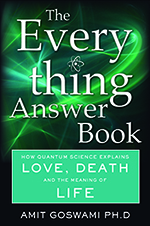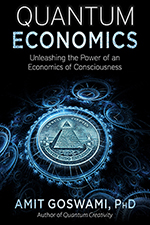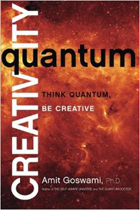Intolerance
By Amit Goswami, Ph. D.
About three thousand years ago, some very creative people in different parts of the world—India, Greece, the Middle East, China—discovered what they thought was a fundamental truth about human beings: behind our immanent separateness there is a transcendent unity. This transcendent unity was called by various names, Spirit for example, and, more recently, consciousness. The traditions these people established are the great spiritual traditions of the world.
Religions grew out of the teachings of these great Masters—they are popularized versions of the great traditions. Their motto first of all was: simplify. People don’t understand what “transcendence” means as opposed to the immanent space-time reality. No matter. Religion equated transcendence with outer space. People can’t visualize let alone explore a unity consciousness with causal power called downward causation. Religions created the idea of God much in the image of a human being, only almighty. In time, further corruption entered.
First, the spiritual traditions gave us the concept of Godly virtues or archetypes like Love and Goodness that they said had to be creatively cultivated. But where is the time for creative investigation for the busy salespeople of religions? So instead, the religious leaders created codified versions of the Great Masters’ realizations called Good books that included codes of spirituality and moral behavior.
Secondly, in time, each religion began to sell their particular religion as the superior or only way to be. People of each religion declared themselves to be the “chosen” people.
In this way, the concept of unity consciousness gave way to a new kind of separateness: us versus them. Obviously, if our religion is superior to yours, should it not be my prerogative to be intolerant about your mistaken religious views? Thus, what culminates is religious intolerance.
However, in the olden days, there was one saving grace built into the system. All religions recognized that truth cannot always be codified as a bunch of rational concepts or laws: logos. Some of the subtle truth had to be conveyed via stories: mythos, mythology. In this way ambiguity entered; and some room for tolerance and multiculturalism was maintained.
Until recently, that is. As everyone knows, religions dominated our worldview until about the sixteenth century. By concentrating on the spiritual, religions ignored the material world to the extent that people lived in material misery. Then modern science came along as a revolt against the spiritual emphasis. In four centuries, science and its offshoot—technology—created unprecedented material wealth.
Eventually, the success of science had a major influence on religions also. Science since it was originally meant for matter can be more or less completely stated in terms of logos, or so it was thought. Mythos was undermined and eventually eliminated from science. This aspect of science carried over to religions which now also began to undermine mythos, and, as a result, religions became logo-centric and unambiguous as a result. The one safeguard against intolerance was gone.
We may call such religions—literal interpretation of Good Books—fundamentalist. But let’s face it. The fundamentalists dominate virtually all religions today. In this way religious intolerance is everywhere, rampant.
Political Intolerance
The story of science versus religion is not complete. For quite a while, there was a truce between the two: science dominated the exploration of the material/outer domain of reality; religion dominated the spiritual/inner. But by the middle of the twentieth century, the success of science became so compelling to its practitioners and the fundamentalism of religions so abhorring, that the practitioners of science gave up on the truce and created their own religion: ironically, their own new dogma—everything is matter and its movement; and there is no other cause than material interactions. Gone was God, gone was downward causation, and gone were mythos.
Today we call the new religion scientific materialism. With its creation, now there are two worldviews: one materialist, the other religious. Both are logo-centric, and, of course, there is huge intolerance between them.
Democracy, it turns out, thrives with a two-party system. Naturally, one of these political parties would be liberal. They would support freedom from dogmas, they would support progress defined as further and further exploration of meaning. Naturally, the other political party would oppose; they would be conservative acting as a needed brake on the progressive agenda of the liberals.
When science was trying to get out of the dogma of religions, liberals naturally supported science. When science itself became dogmatic, this habit has continued. So liberals, with few exceptions, contrary to the spirit of the word, now have a dogma, scientific materialism. Most conservatives, of course, now unabashedly support the opposing dogma of religions.
Before the polarization of the dogmas, leaders of the liberal parties used political power to help the middle class to process meaning. Even the conservatives were not against meaning processing when mythos was important. So the two parties occasionally could work together for the good of the society. But with dogma taking hold of both parties, mythos was banished and with it the diversity of meaning. So political power is now used more and more to dominate people. In this way political intolerance has a new feature—domination is everything, compromise is unthinkable.
The Remedy
The healing of polarization, intolerance, and domination seeking is found in an integrative worldview. And this is what the quantum worldview is about—integration of science and spirituality. In quantum physics, objects are potentialities of consciousness to choose from, they belong to the transcendent domain of reality. The choice (downward causation) by consciousness creates the immanent space-time domain. The potentialities of consciousness consist of both matter and mind; so meaning, feeling, and values all come back in science. We recognize that the job of the material world is to make representations of consciousness and the subtle worlds of meaning, feelings, and archetypal values. Matter follows logos; but the subtle needs mythos to express its secrets. With mythos back in the game, ambiguity returns and with it comes tolerance.
But of course, it is going to be a struggle to establish the quantum worldview in the saddle; the forces of the status quo are too strong. We need quantum activism—people willing to devote their creativity in the service of consciousness and the quantum worldview that recognizes the supremacy of consciousness. We need new political leaders. The good news is that with the recognition of the importance of meaning and archetypal values, with quantum activism guiding their lives, people once more are exploring meaning. The new leaders who will dedicate their power to serve the movement of consciousness toward meaning and values will no doubt emerge from the same movement of quantum activism.



